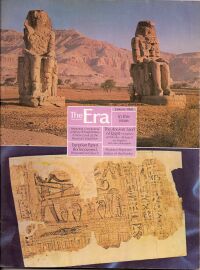Why is the Book of Abraham text not on the papyri?
Topics
Summary: We do not claim to know why the text of the Book of Abraham (or the missing Book of Joseph) is not in evidence on the fragments of papyrus that were recovered. Critics, of course, simply assume this to be conclusive evidence that Joseph was a fraud. From a believer's perspective, however, there are several possible theories to account for this: 1) The text was revealed much in the same manner as that of the Book of Mormon, without the need for the actual papyri, 2) The text was present on portions of the papyri that are missing, and 3) The Book of Abraham manuscript was attached to the Book of Breathings manuscript and was lost. 4) Perhaps there was a way of understanding the Egyptian ideograms anciently that is unknown to Egyptology in our day, yet to be discovered, deciphered or acknowledged, that could yield an interpretation of a text that is different than the standard Egyptological reading.
Summary: This theory assumes that the Book of Abraham
was not on the papyri; he received the text by revelation, with the papyri acting as a catalyst. This is a possibility because Joseph used the word "translation" to mean several things, including the process of receiving pure revelation. (Joseph Smith's revelations call his revision of the Bible a "translation" (
D&C 73:4; 76:15; 90:13; 94:10; 124:89), even though he didn't use any Hebrew of Greek manuscripts. Also,
DC 7 is a revealed translation of a lost record written by the Apostle John.)
Summary: This theory assumes that the Book of Abraham
was on the papyri in Joseph Smith's possession, but the portion recovered from the Metropolitan Museum doesn't include it. This is a possibility because the recovered portion is less than 13% of the total material held by Joseph.
[1] Eyewitnesses also reported that the length of the papyri in Joseph's possession was much more extensive than the fragments now held by the Church.
[2]
Summary: This theory assumes that the Book of Abraham was on a scroll which is no longer extant. While it's true that the extant portions of the JSP are from the Book of the Dead and the Book of Breathings and do not, according to Egyptologists, translate to anything like the LDS Book of Abraham, this doesn't necessarily mean that the translation didn't derive from Joseph's papyri. There are other scenarios that are compatible with Joseph's claims. We know from other sources, for instance, that sometimes scrolls were attached together.
<videoflash>76kANp4cxQg</videoflash>
- ↑ John Gee, A Guide to the Joseph Smith Papyri (Provo, Utah: FARMS, 2000), 23.
- ↑ "In 1906, while visiting Nauvoo, President Joseph F. Smith related to Preston Nibley his experience as a child of seeing his Uncle Joseph in the front rooms of the Mansion House working on the Egyptian manuscripts. According to President Smith, one of the rolls of papyri "when unrolled on the floor extended through two rooms of the Mansion House." This would have been sometime between 1843 when the Mansion House was completed and the prophet's death in June 1844, one or two years after other parts of the papyri had been cut up and placed under glass. - See Hugh Nibley, "Phase I," Dialogue: A Journal of Mormon Thought 3 no. 2 (Summer 1968), 101. See also Hugh Nibley, "New Look at the Pearl of Great Price," Improvement Era 71 (March 1968), 17–18. and Hugh Nibley, "Judging and Prejudging the Book of Abraham," Nibley archive, 1979, 6-7; reprinted as an appendix in Robert L. and Rosemary Brown, They Lie in Wait to Deceive, vol. 1, ed. Barbara Ellsworth, rev. ed. (Mesa, AZ: Brownsworth, 1982), 236—245.


